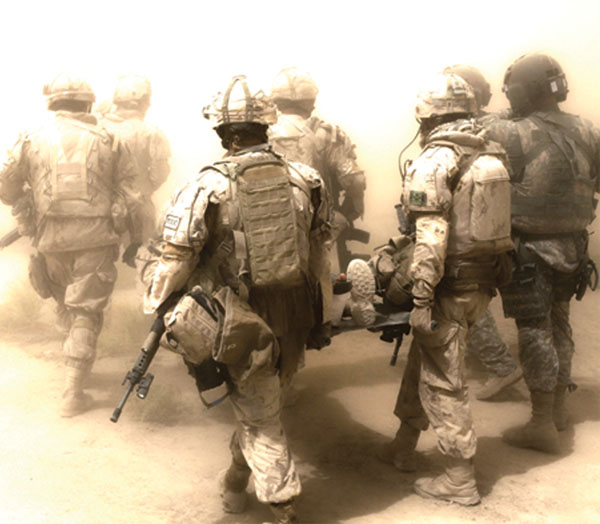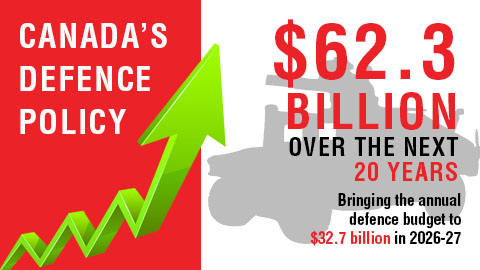
[Adam Day]
It’s easy enough to say Canada’s military needs more and better ships, planes and armoured vehicles, but acquiring them takes time and inevitably more than one government to achieve. It’s like turning the proverbial aircraft carrier around, and changing captain and crew in the process.
Procurement is painfully complicated and slow, no doubt. But it’s not procurement that’s at the root of the problem. The fact is, Canadian governments are fickle and weak when it comes to defence.
Granted, the nature of Canada—its geographic size, small population and social policies—play a role in the perennial lack of defence funding and the resultant shortages of equipment and, often, personnel.
Add to that a historic absence of political consensus on the issue, as well as a cripplingly complex and bureaucratic procurement process, and it’s easy to see how Canada’s military suffers.
Now the Liberals have produced a much-anticipated defence policy review, the first in nine years. It’s a commentary in and of itself that, in a sector where progress is measured in decades, a government is producing a new policy just nine years after the last one.
A sweeping package of promises and good intentions, the defence review came on the heels of a foreign policy statement that said Canada and the world can no longer rely on U.S. leadership and must chart its own course. And the foreign policy document said Canada needs a strong military to do it.
“To rely solely on the U.S. security umbrella would make us a client state,” warned Foreign Affairs Minister Chrystia Freeland. “And…such a dependence would not be in Canada’s interest. That is why doing our fair share is clearly necessary.
“It is by pulling our weight in this partnership, and in all our international partnerships, that we, in fact, have weight.
“To put it plainly: Canadian diplomacy and development sometimes require the backing of hard power. Force is of course always a last resort. But the principled use of force, together with our allies and governed by international law, is part of our history and must be part of our future.”

The defence policy review, drafted to meet or enhance domestic, continental and international commitments alike, promises new defence spending of $62.3 billion over the next 20 years, bringing the annual defence budget to $32.7 billion in 2026-27 from $18.9 billion this fiscal year.
The new money is to include $47.2 billion in capital funds for new projects and $15.1 billion for operating expenses. Defence spending over the next 20 years is projected to be $553 billion, not including mission support. It’s a lot of money but a fact of life and, for some, not enough.
At 1.4 per cent by 2024-25, it will still fall short of the North Atlantic Treaty Organization’s (NATO) dubious two per cent of GDP standard, which has been shown to be an arbitrary and an unreliable measure of a country’s contributions to the alliance.
The Liberal paper promises surveillance aircraft, remotely piloted systems and space-based capabilities. There are 15 new combat ships, enhanced submarine capabilities, two joint support vessels and as many as six new Arctic icebreakers.
The plan looks to acquire 88 new fighter aircraft—more than previously forecast—and stock a new fleet of army vehicles of every kind.
There’s a more robust intelligence contingent, advance cyber operations, an expanded Arctic presence and 605 new special forces troops. The regular force is to grow by 3,500 to 71,500, and the reserves by 1,500 to 30,000.
It will help boost enrolment by offering better wages and services, promising to devote more resources to career development, benefits and retirement processes, including more than $198 million more for health and wellness.
It also promises to modernize and streamline defence procurement, including cutting approval times in half for low-risk and less complex projects.
Given the history of successive governments, the likelihood that all of this will happen in just the way it is planned seems remote. But as various media pundits have advanced, it is a policy that Conservatives could endorse, as it sounds more like something that would come from them than past Liberal governments.
Politics being what it is, however, the first Opposition reaction was negative.
“Since coming to office, the Liberals have consistently cut the Department of National Defence’s budget and made a mess of important procurement projects, including replacing our fighter jets and navy vessels,” said the Tory defence critic, James Bezan. “No matter what they would have you believe, the Liberals have lost all credibility when it comes to national defence.”
Nevertheless, elements of the policy, like taking better care of Forces personnel from the day they sign up through retirement, would be hard to oppose, unless they demanded more. And, regardless of past indiscretions, the need for new equipment is indisputable—for sovereignty, let alone other commitments.
The U.S. defence secretary, retired Marine general James Mattis, had good things to say about the policy paper, declaring the Americans “heartened” by it. “The United States welcomes Canada’s marked increase in investment in their military and their continued commitment to a strong defence relationship with the United States and NATO,” he said.
“This new defence policy demonstrates Canadian resolve to build additional military capacity and a more capable fighting force. In light of today’s security challenges around the world, it’s critical for Canada’s moral voice to be supported by the hard power of a strong military.”
Said Jens Stoltenberg, NATO secretary general: “I warmly welcome Canada’s new defence policy and the major planned investments in security and defence. This new policy affirms Canada’s unwavering commitment to NATO and will ensure Canada has the armed forces and key capabilities that the alliance needs.”
Advertisement






















